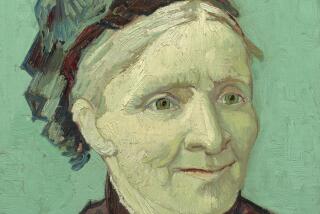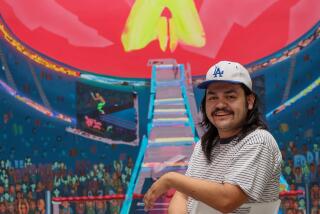ART REVIEW : CATCHING FISCHL’S ‘EYES’
- Share via
It always unsettles our preconceptions to learn that a gangster loves puppies or a clergyman is seducing his flock. Now it turns out that Eric Fischl’s strange paintings about moral decay in suburbia conceal a thick vein of languorous hedonism and a real love of ordinary life.
Fischl’s retrospective exhibition at Manhattan’s Whitney Museum earlier this year was lumbered with big canvases seemingly intent on provoking viewers into thoughts of incest, bestiality and assorted kinks running rife among backyard barbecues and weekend beach condos. They are sting paintings that excite prurient interest and entrap in guilt.
Now Fischl’s art shows up in a traveling exhibition at Cal State Long Beach’s University Art Museum through Nov. 30.
Organized by museum director Constance Glenn, it is a penetrating whisper of a show called “Scenes Before the Eyes,” and includes 50 prints and drawings relating to two large graphic works, “Floating Island” and “Year of the Drowned Dog.”
Some of Fischl’s familiar narrative content can be read into the work but what we get here mainly is Fischl as a pure figurative artist and a perceptive captor of visual anecdote. When this guy draws a girl lounging before the TV or a child on the beach pulling off his shorts, the observation is so deft it almost gets past us.
How many times have we all been in that balancing postion where the knee is up and the shorts half off? If anything goes wrong with that delicate balance, the next thing you know you are hopping around on one foot and falling over laughing.
Not that anyone laughs much in this art. Mainly it is bathed in a lazy calm like a crystalline summer day at the seaside or a dopey lounge in front of the tube when you actually want the program to be comfortingly mindless.
Fischl revels in that somnambulistic hedonism. Except for a study of a nude from a photo by George Platt Lynnes, he almost never draws with a real line. He draws with goopy brush strokes that play up the physical density of flesh flapping on bones. The brush does skid into meaningless smears but it is amazing how often he can make it simultaneously describe the edge of a form, the rumples of slept-in sheets and the differences in the kind of light that filters from the TV or the silhouetting glare of sun on the sand.
There are elements of the familiar Fischl here--the slightly threatening gait of a man walking against the light, the bruised, Munch-like treatment of a girl on a bed. Mainly however we see the normally muffled side of this art and it puts us in mind of aesthetic slice-of-life artists like Fairfield Porter or early Richard Diebenkorn.
Fischl goes out of his way to call attention to his working methods. “Drowned Dog” is a long-panel beach scene where onlookers gather around a boy who retrieves the body of a dog from the surf. In several versions we see figures added to the landscape on different sheets of paper. Even the final version consists of pieced-together sheets. The exposed methodology dramatizes the narrative and makes it less important. Since this is a print, the effect had to be calculated but even the “planned spontaneity” further sublimates the work.
Fischl would almost certainly not be the celebrated and controversial artist he is today without his sensational subject matter. Partly its use poses legitimate issues about the narrative role in art; partly its use makes the art seem exploitative and exhibitionistic.
Either way, anybody who likes art for its own sake will enjoy seeing Fischl when he is not straining so hard. It’s nice to know he likes puppies.
More to Read
The biggest entertainment stories
Get our big stories about Hollywood, film, television, music, arts, culture and more right in your inbox as soon as they publish.
You may occasionally receive promotional content from the Los Angeles Times.










